Financial Accounting: Users of Accounting Information, Differences with Management Accounting, Fundamental Concepts, and Financial Statements
VerifiedAdded on 2023/06/10
|11
|2154
|190
AI Summary
This report discusses the uses of Sainsbury’s Accounting Information, differences between Financial Accounting and Management Accounting, fundamental concepts of accounting, and the two main types of Financial Statements with sample formats. It identifies four users of Sainsbury’s Accounting Information and why each needs the Accounting Information, explains four main differences between Financial Accounting and Management Accounting, and provides illustrations of four fundamental concepts of accounting. It also distinguishes between the two main types of Financial Statement by constructing sample formats from each.
Contribute Materials
Your contribution can guide someone’s learning journey. Share your
documents today.
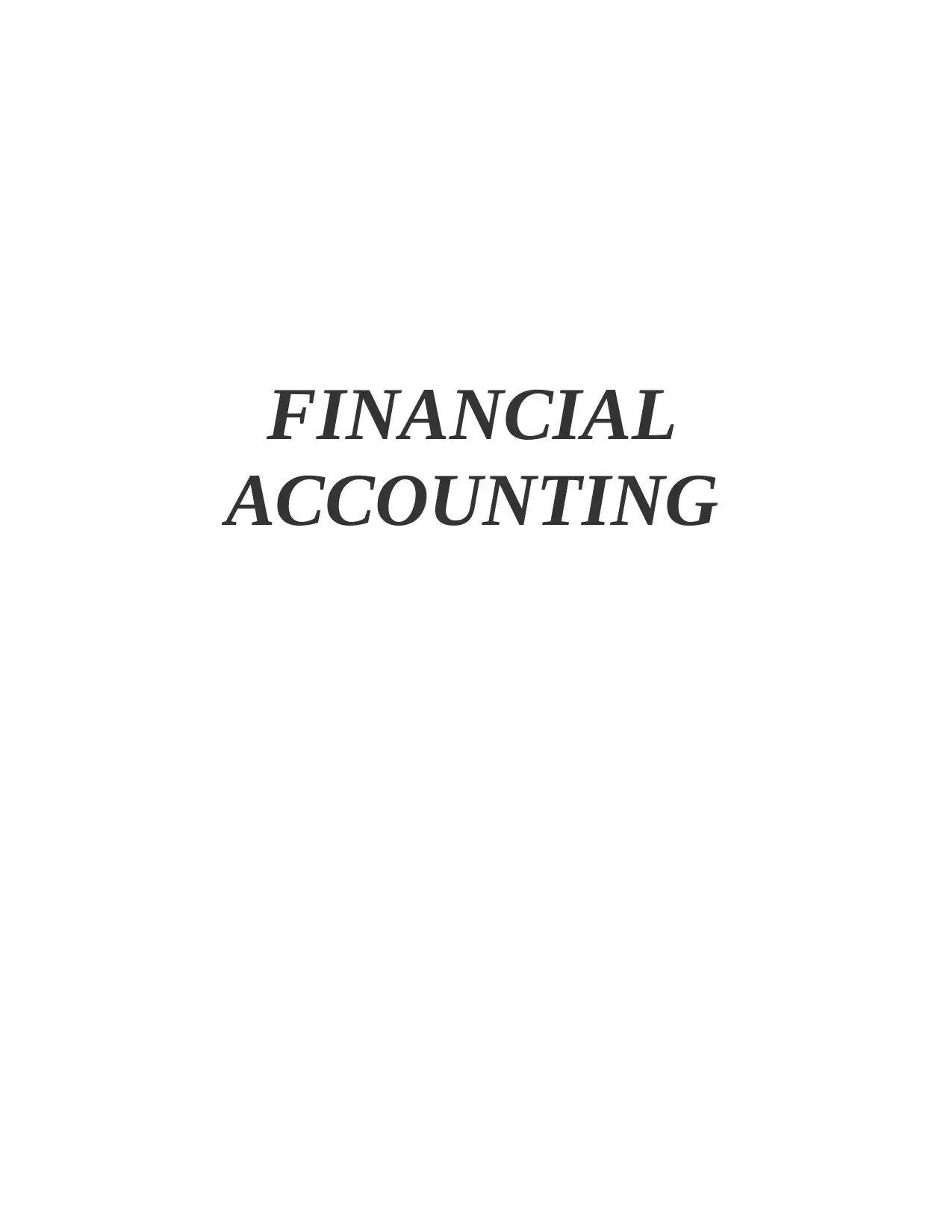
FINANCIAL
ACCOUNTING
ACCOUNTING
Secure Best Marks with AI Grader
Need help grading? Try our AI Grader for instant feedback on your assignments.
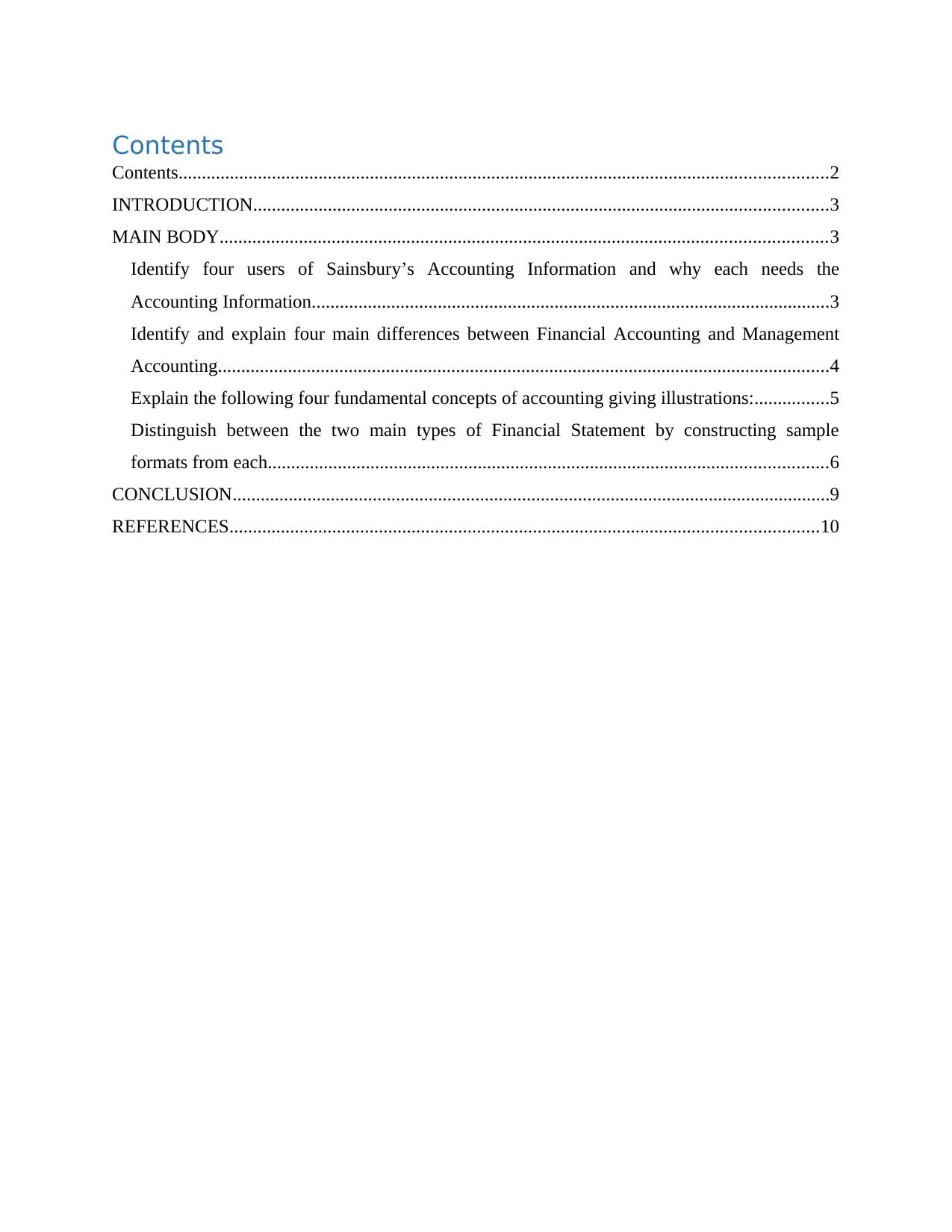
Contents
Contents...........................................................................................................................................2
INTRODUCTION...........................................................................................................................3
MAIN BODY..................................................................................................................................3
Identify four users of Sainsbury’s Accounting Information and why each needs the
Accounting Information...............................................................................................................3
Identify and explain four main differences between Financial Accounting and Management
Accounting...................................................................................................................................4
Explain the following four fundamental concepts of accounting giving illustrations:................5
Distinguish between the two main types of Financial Statement by constructing sample
formats from each........................................................................................................................6
CONCLUSION................................................................................................................................9
REFERENCES..............................................................................................................................10
Contents...........................................................................................................................................2
INTRODUCTION...........................................................................................................................3
MAIN BODY..................................................................................................................................3
Identify four users of Sainsbury’s Accounting Information and why each needs the
Accounting Information...............................................................................................................3
Identify and explain four main differences between Financial Accounting and Management
Accounting...................................................................................................................................4
Explain the following four fundamental concepts of accounting giving illustrations:................5
Distinguish between the two main types of Financial Statement by constructing sample
formats from each........................................................................................................................6
CONCLUSION................................................................................................................................9
REFERENCES..............................................................................................................................10
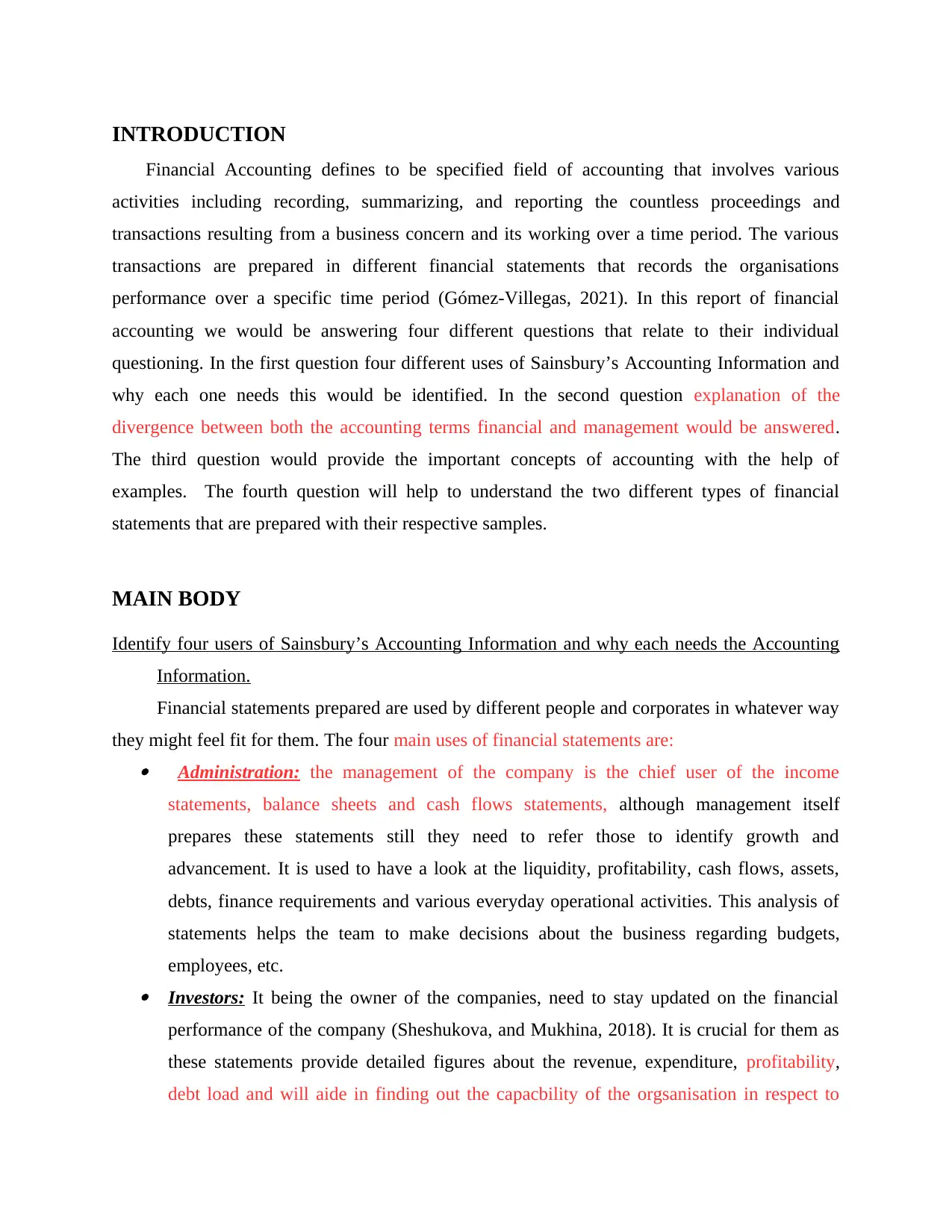
INTRODUCTION
Financial Accounting defines to be specified field of accounting that involves various
activities including recording, summarizing, and reporting the countless proceedings and
transactions resulting from a business concern and its working over a time period. The various
transactions are prepared in different financial statements that records the organisations
performance over a specific time period (Gómez-Villegas, 2021). In this report of financial
accounting we would be answering four different questions that relate to their individual
questioning. In the first question four different uses of Sainsbury’s Accounting Information and
why each one needs this would be identified. In the second question explanation of the
divergence between both the accounting terms financial and management would be answered.
The third question would provide the important concepts of accounting with the help of
examples. The fourth question will help to understand the two different types of financial
statements that are prepared with their respective samples.
MAIN BODY
Identify four users of Sainsbury’s Accounting Information and why each needs the Accounting
Information.
Financial statements prepared are used by different people and corporates in whatever way
they might feel fit for them. The four main uses of financial statements are: Administration: the management of the company is the chief user of the income
statements, balance sheets and cash flows statements, although management itself
prepares these statements still they need to refer those to identify growth and
advancement. It is used to have a look at the liquidity, profitability, cash flows, assets,
debts, finance requirements and various everyday operational activities. This analysis of
statements helps the team to make decisions about the business regarding budgets,
employees, etc. Investors: It being the owner of the companies, need to stay updated on the financial
performance of the company (Sheshukova, and Mukhina, 2018). It is crucial for them as
these statements provide detailed figures about the revenue, expenditure, profitability,
debt load and will aide in finding out the capacbility of the orgsanisation in respect to
Financial Accounting defines to be specified field of accounting that involves various
activities including recording, summarizing, and reporting the countless proceedings and
transactions resulting from a business concern and its working over a time period. The various
transactions are prepared in different financial statements that records the organisations
performance over a specific time period (Gómez-Villegas, 2021). In this report of financial
accounting we would be answering four different questions that relate to their individual
questioning. In the first question four different uses of Sainsbury’s Accounting Information and
why each one needs this would be identified. In the second question explanation of the
divergence between both the accounting terms financial and management would be answered.
The third question would provide the important concepts of accounting with the help of
examples. The fourth question will help to understand the two different types of financial
statements that are prepared with their respective samples.
MAIN BODY
Identify four users of Sainsbury’s Accounting Information and why each needs the Accounting
Information.
Financial statements prepared are used by different people and corporates in whatever way
they might feel fit for them. The four main uses of financial statements are: Administration: the management of the company is the chief user of the income
statements, balance sheets and cash flows statements, although management itself
prepares these statements still they need to refer those to identify growth and
advancement. It is used to have a look at the liquidity, profitability, cash flows, assets,
debts, finance requirements and various everyday operational activities. This analysis of
statements helps the team to make decisions about the business regarding budgets,
employees, etc. Investors: It being the owner of the companies, need to stay updated on the financial
performance of the company (Sheshukova, and Mukhina, 2018). It is crucial for them as
these statements provide detailed figures about the revenue, expenditure, profitability,
debt load and will aide in finding out the capacbility of the orgsanisation in respect to
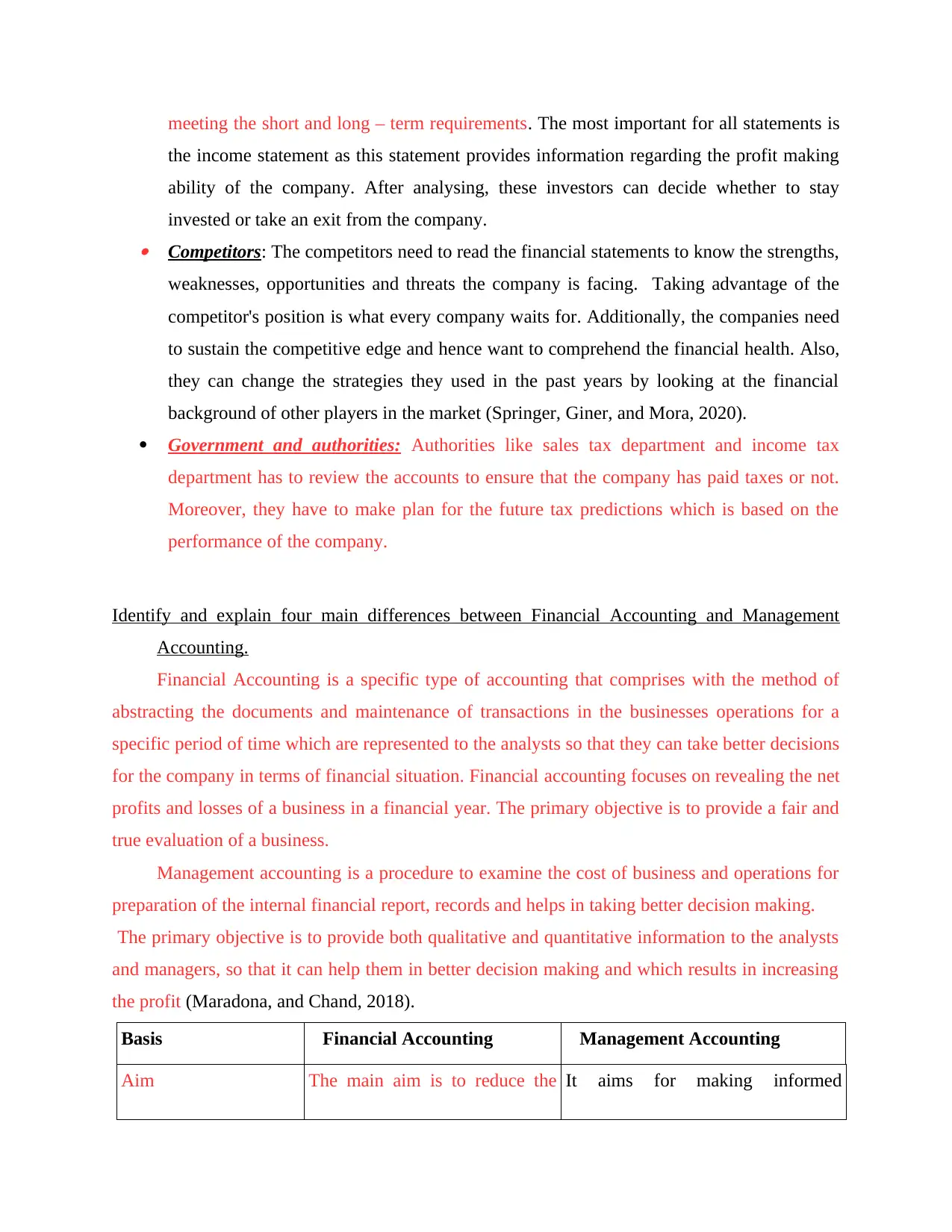
meeting the short and long – term requirements. The most important for all statements is
the income statement as this statement provides information regarding the profit making
ability of the company. After analysing, these investors can decide whether to stay
invested or take an exit from the company. Competitors: The competitors need to read the financial statements to know the strengths,
weaknesses, opportunities and threats the company is facing. Taking advantage of the
competitor's position is what every company waits for. Additionally, the companies need
to sustain the competitive edge and hence want to comprehend the financial health. Also,
they can change the strategies they used in the past years by looking at the financial
background of other players in the market (Springer, Giner, and Mora, 2020).
Government and authorities: Authorities like sales tax department and income tax
department has to review the accounts to ensure that the company has paid taxes or not.
Moreover, they have to make plan for the future tax predictions which is based on the
performance of the company.
Identify and explain four main differences between Financial Accounting and Management
Accounting.
Financial Accounting is a specific type of accounting that comprises with the method of
abstracting the documents and maintenance of transactions in the businesses operations for a
specific period of time which are represented to the analysts so that they can take better decisions
for the company in terms of financial situation. Financial accounting focuses on revealing the net
profits and losses of a business in a financial year. The primary objective is to provide a fair and
true evaluation of a business.
Management accounting is a procedure to examine the cost of business and operations for
preparation of the internal financial report, records and helps in taking better decision making.
The primary objective is to provide both qualitative and quantitative information to the analysts
and managers, so that it can help them in better decision making and which results in increasing
the profit (Maradona, and Chand, 2018).
Basis Financial Accounting Management Accounting
Aim The main aim is to reduce the It aims for making informed
the income statement as this statement provides information regarding the profit making
ability of the company. After analysing, these investors can decide whether to stay
invested or take an exit from the company. Competitors: The competitors need to read the financial statements to know the strengths,
weaknesses, opportunities and threats the company is facing. Taking advantage of the
competitor's position is what every company waits for. Additionally, the companies need
to sustain the competitive edge and hence want to comprehend the financial health. Also,
they can change the strategies they used in the past years by looking at the financial
background of other players in the market (Springer, Giner, and Mora, 2020).
Government and authorities: Authorities like sales tax department and income tax
department has to review the accounts to ensure that the company has paid taxes or not.
Moreover, they have to make plan for the future tax predictions which is based on the
performance of the company.
Identify and explain four main differences between Financial Accounting and Management
Accounting.
Financial Accounting is a specific type of accounting that comprises with the method of
abstracting the documents and maintenance of transactions in the businesses operations for a
specific period of time which are represented to the analysts so that they can take better decisions
for the company in terms of financial situation. Financial accounting focuses on revealing the net
profits and losses of a business in a financial year. The primary objective is to provide a fair and
true evaluation of a business.
Management accounting is a procedure to examine the cost of business and operations for
preparation of the internal financial report, records and helps in taking better decision making.
The primary objective is to provide both qualitative and quantitative information to the analysts
and managers, so that it can help them in better decision making and which results in increasing
the profit (Maradona, and Chand, 2018).
Basis Financial Accounting Management Accounting
Aim The main aim is to reduce the It aims for making informed
Secure Best Marks with AI Grader
Need help grading? Try our AI Grader for instant feedback on your assignments.
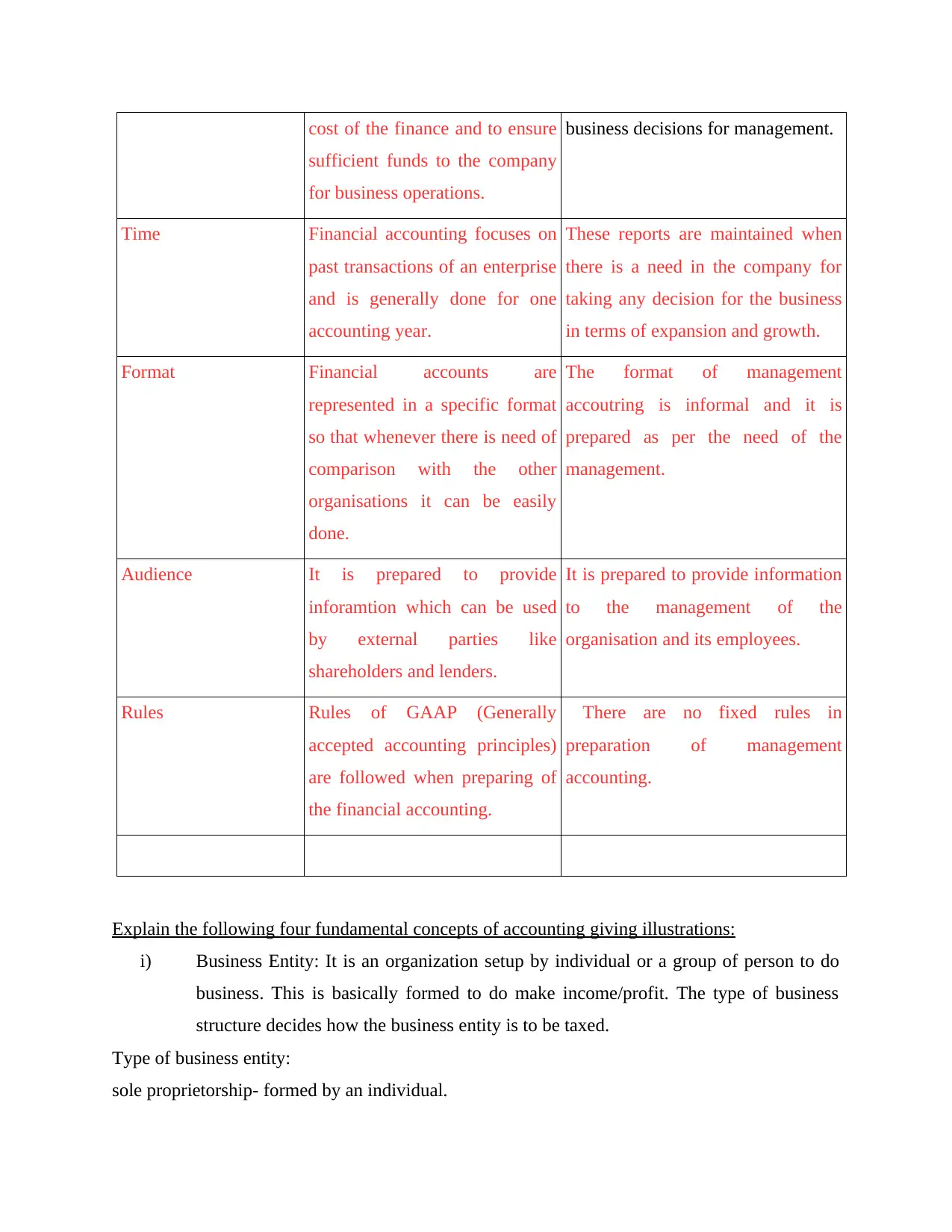
cost of the finance and to ensure
sufficient funds to the company
for business operations.
business decisions for management.
Time Financial accounting focuses on
past transactions of an enterprise
and is generally done for one
accounting year.
These reports are maintained when
there is a need in the company for
taking any decision for the business
in terms of expansion and growth.
Format Financial accounts are
represented in a specific format
so that whenever there is need of
comparison with the other
organisations it can be easily
done.
The format of management
accoutring is informal and it is
prepared as per the need of the
management.
Audience It is prepared to provide
inforamtion which can be used
by external parties like
shareholders and lenders.
It is prepared to provide information
to the management of the
organisation and its employees.
Rules Rules of GAAP (Generally
accepted accounting principles)
are followed when preparing of
the financial accounting.
There are no fixed rules in
preparation of management
accounting.
Explain the following four fundamental concepts of accounting giving illustrations:
i) Business Entity: It is an organization setup by individual or a group of person to do
business. This is basically formed to do make income/profit. The type of business
structure decides how the business entity is to be taxed.
Type of business entity:
sole proprietorship- formed by an individual.
sufficient funds to the company
for business operations.
business decisions for management.
Time Financial accounting focuses on
past transactions of an enterprise
and is generally done for one
accounting year.
These reports are maintained when
there is a need in the company for
taking any decision for the business
in terms of expansion and growth.
Format Financial accounts are
represented in a specific format
so that whenever there is need of
comparison with the other
organisations it can be easily
done.
The format of management
accoutring is informal and it is
prepared as per the need of the
management.
Audience It is prepared to provide
inforamtion which can be used
by external parties like
shareholders and lenders.
It is prepared to provide information
to the management of the
organisation and its employees.
Rules Rules of GAAP (Generally
accepted accounting principles)
are followed when preparing of
the financial accounting.
There are no fixed rules in
preparation of management
accounting.
Explain the following four fundamental concepts of accounting giving illustrations:
i) Business Entity: It is an organization setup by individual or a group of person to do
business. This is basically formed to do make income/profit. The type of business
structure decides how the business entity is to be taxed.
Type of business entity:
sole proprietorship- formed by an individual.
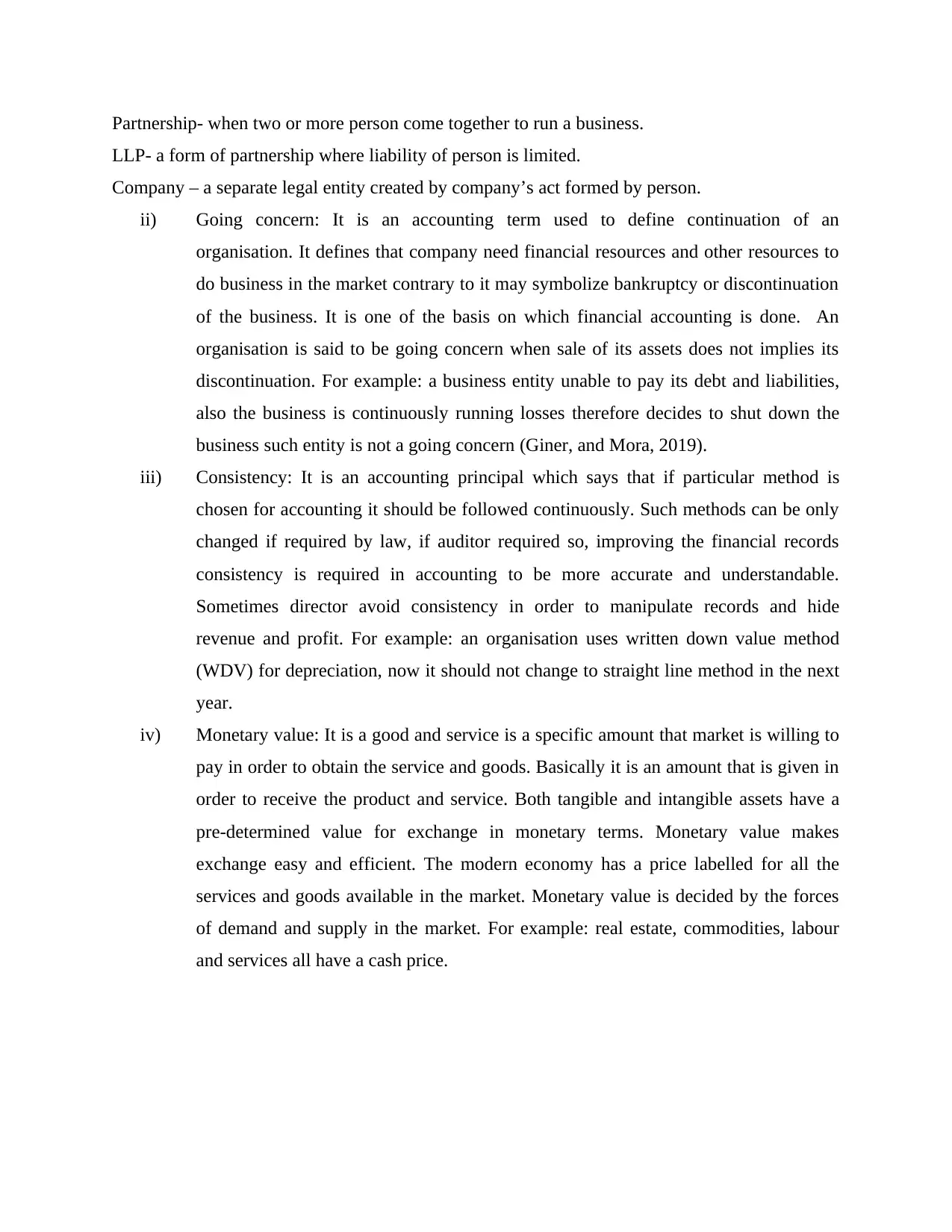
Partnership- when two or more person come together to run a business.
LLP- a form of partnership where liability of person is limited.
Company – a separate legal entity created by company’s act formed by person.
ii) Going concern: It is an accounting term used to define continuation of an
organisation. It defines that company need financial resources and other resources to
do business in the market contrary to it may symbolize bankruptcy or discontinuation
of the business. It is one of the basis on which financial accounting is done. An
organisation is said to be going concern when sale of its assets does not implies its
discontinuation. For example: a business entity unable to pay its debt and liabilities,
also the business is continuously running losses therefore decides to shut down the
business such entity is not a going concern (Giner, and Mora, 2019).
iii) Consistency: It is an accounting principal which says that if particular method is
chosen for accounting it should be followed continuously. Such methods can be only
changed if required by law, if auditor required so, improving the financial records
consistency is required in accounting to be more accurate and understandable.
Sometimes director avoid consistency in order to manipulate records and hide
revenue and profit. For example: an organisation uses written down value method
(WDV) for depreciation, now it should not change to straight line method in the next
year.
iv) Monetary value: It is a good and service is a specific amount that market is willing to
pay in order to obtain the service and goods. Basically it is an amount that is given in
order to receive the product and service. Both tangible and intangible assets have a
pre-determined value for exchange in monetary terms. Monetary value makes
exchange easy and efficient. The modern economy has a price labelled for all the
services and goods available in the market. Monetary value is decided by the forces
of demand and supply in the market. For example: real estate, commodities, labour
and services all have a cash price.
LLP- a form of partnership where liability of person is limited.
Company – a separate legal entity created by company’s act formed by person.
ii) Going concern: It is an accounting term used to define continuation of an
organisation. It defines that company need financial resources and other resources to
do business in the market contrary to it may symbolize bankruptcy or discontinuation
of the business. It is one of the basis on which financial accounting is done. An
organisation is said to be going concern when sale of its assets does not implies its
discontinuation. For example: a business entity unable to pay its debt and liabilities,
also the business is continuously running losses therefore decides to shut down the
business such entity is not a going concern (Giner, and Mora, 2019).
iii) Consistency: It is an accounting principal which says that if particular method is
chosen for accounting it should be followed continuously. Such methods can be only
changed if required by law, if auditor required so, improving the financial records
consistency is required in accounting to be more accurate and understandable.
Sometimes director avoid consistency in order to manipulate records and hide
revenue and profit. For example: an organisation uses written down value method
(WDV) for depreciation, now it should not change to straight line method in the next
year.
iv) Monetary value: It is a good and service is a specific amount that market is willing to
pay in order to obtain the service and goods. Basically it is an amount that is given in
order to receive the product and service. Both tangible and intangible assets have a
pre-determined value for exchange in monetary terms. Monetary value makes
exchange easy and efficient. The modern economy has a price labelled for all the
services and goods available in the market. Monetary value is decided by the forces
of demand and supply in the market. For example: real estate, commodities, labour
and services all have a cash price.
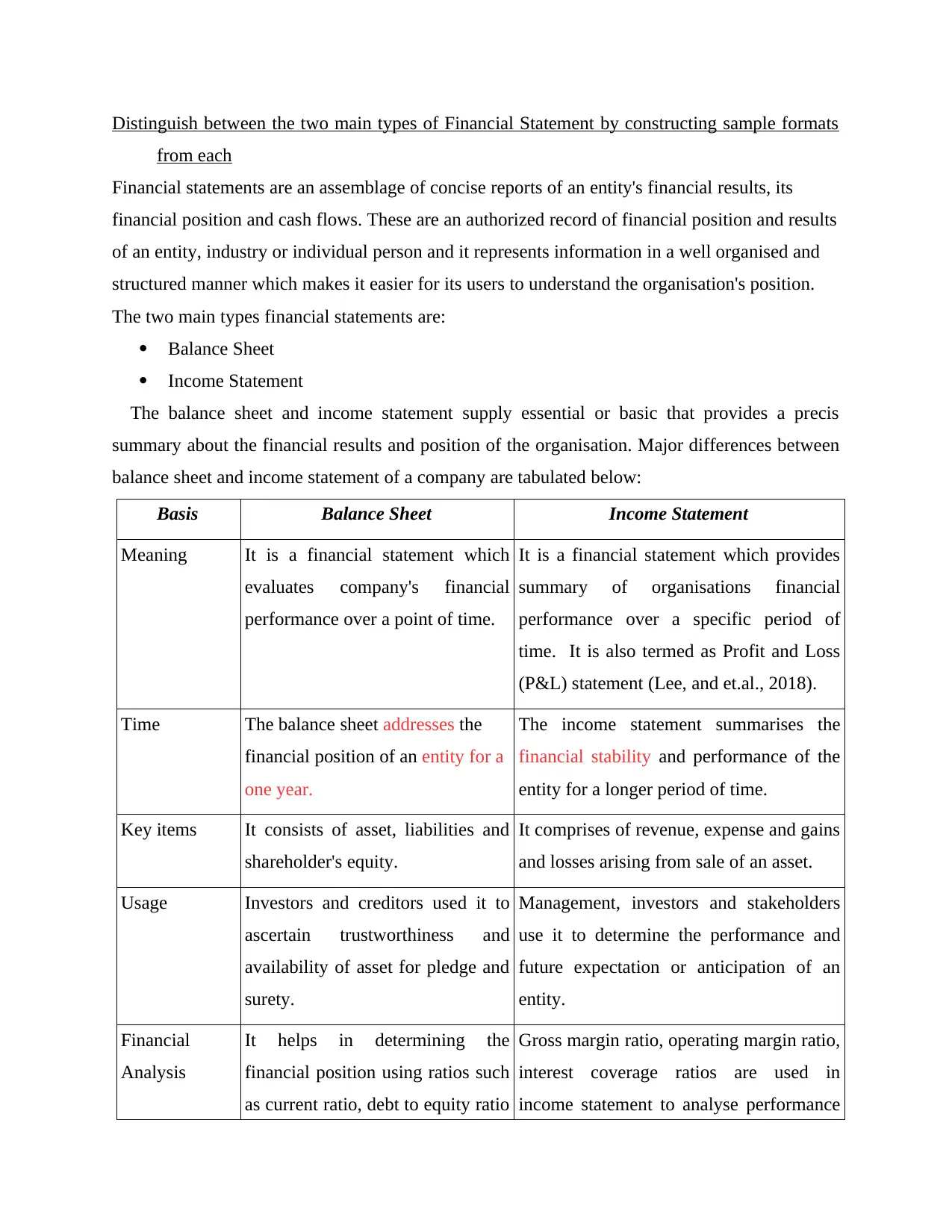
Distinguish between the two main types of Financial Statement by constructing sample formats
from each
Financial statements are an assemblage of concise reports of an entity's financial results, its
financial position and cash flows. These are an authorized record of financial position and results
of an entity, industry or individual person and it represents information in a well organised and
structured manner which makes it easier for its users to understand the organisation's position.
The two main types financial statements are:
Balance Sheet
Income Statement
The balance sheet and income statement supply essential or basic that provides a precis
summary about the financial results and position of the organisation. Major differences between
balance sheet and income statement of a company are tabulated below:
Basis Balance Sheet Income Statement
Meaning It is a financial statement which
evaluates company's financial
performance over a point of time.
It is a financial statement which provides
summary of organisations financial
performance over a specific period of
time. It is also termed as Profit and Loss
(P&L) statement (Lee, and et.al., 2018).
Time The balance sheet addresses the
financial position of an entity for a
one year.
The income statement summarises the
financial stability and performance of the
entity for a longer period of time.
Key items It consists of asset, liabilities and
shareholder's equity.
It comprises of revenue, expense and gains
and losses arising from sale of an asset.
Usage Investors and creditors used it to
ascertain trustworthiness and
availability of asset for pledge and
surety.
Management, investors and stakeholders
use it to determine the performance and
future expectation or anticipation of an
entity.
Financial
Analysis
It helps in determining the
financial position using ratios such
as current ratio, debt to equity ratio
Gross margin ratio, operating margin ratio,
interest coverage ratios are used in
income statement to analyse performance
from each
Financial statements are an assemblage of concise reports of an entity's financial results, its
financial position and cash flows. These are an authorized record of financial position and results
of an entity, industry or individual person and it represents information in a well organised and
structured manner which makes it easier for its users to understand the organisation's position.
The two main types financial statements are:
Balance Sheet
Income Statement
The balance sheet and income statement supply essential or basic that provides a precis
summary about the financial results and position of the organisation. Major differences between
balance sheet and income statement of a company are tabulated below:
Basis Balance Sheet Income Statement
Meaning It is a financial statement which
evaluates company's financial
performance over a point of time.
It is a financial statement which provides
summary of organisations financial
performance over a specific period of
time. It is also termed as Profit and Loss
(P&L) statement (Lee, and et.al., 2018).
Time The balance sheet addresses the
financial position of an entity for a
one year.
The income statement summarises the
financial stability and performance of the
entity for a longer period of time.
Key items It consists of asset, liabilities and
shareholder's equity.
It comprises of revenue, expense and gains
and losses arising from sale of an asset.
Usage Investors and creditors used it to
ascertain trustworthiness and
availability of asset for pledge and
surety.
Management, investors and stakeholders
use it to determine the performance and
future expectation or anticipation of an
entity.
Financial
Analysis
It helps in determining the
financial position using ratios such
as current ratio, debt to equity ratio
Gross margin ratio, operating margin ratio,
interest coverage ratios are used in
income statement to analyse performance
Paraphrase This Document
Need a fresh take? Get an instant paraphrase of this document with our AI Paraphraser
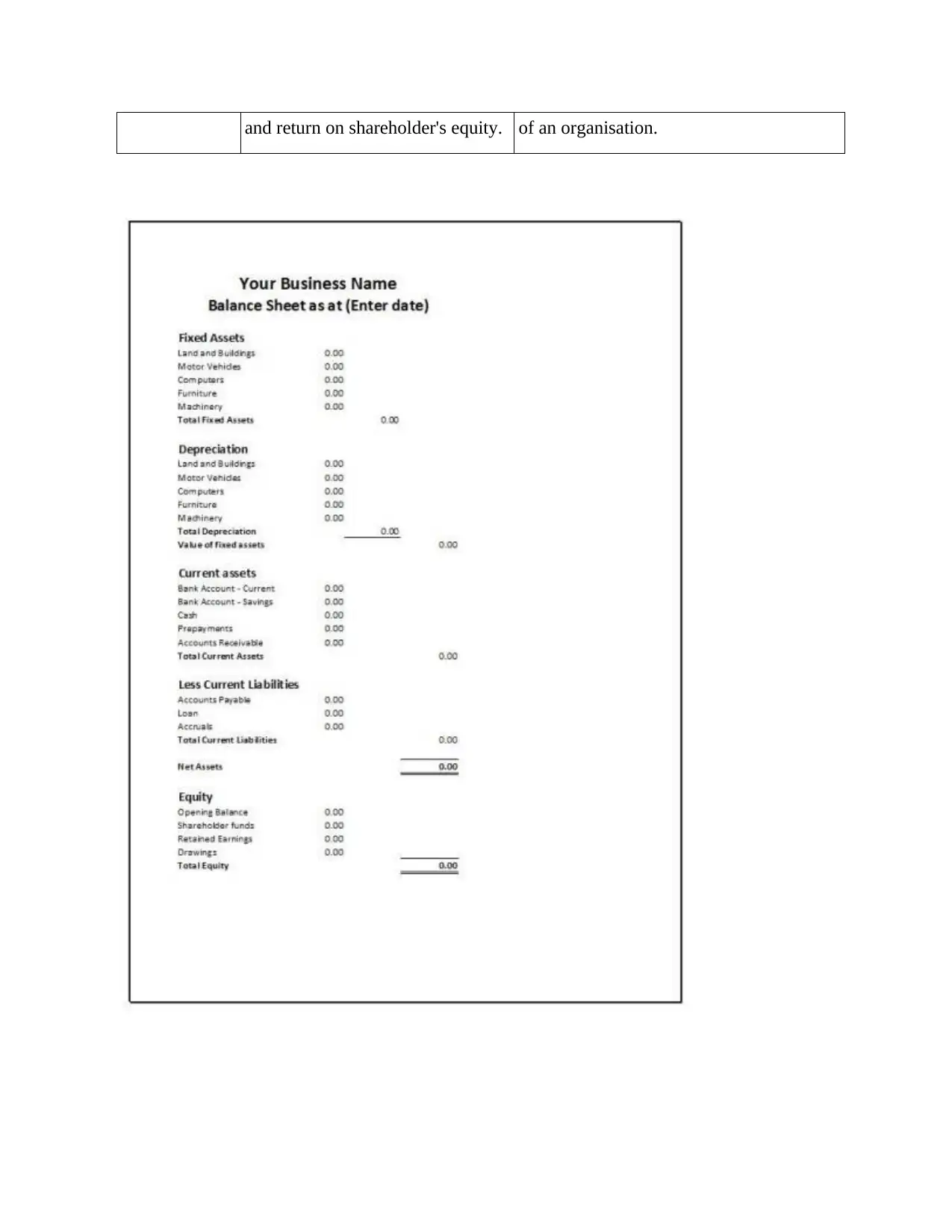
and return on shareholder's equity. of an organisation.
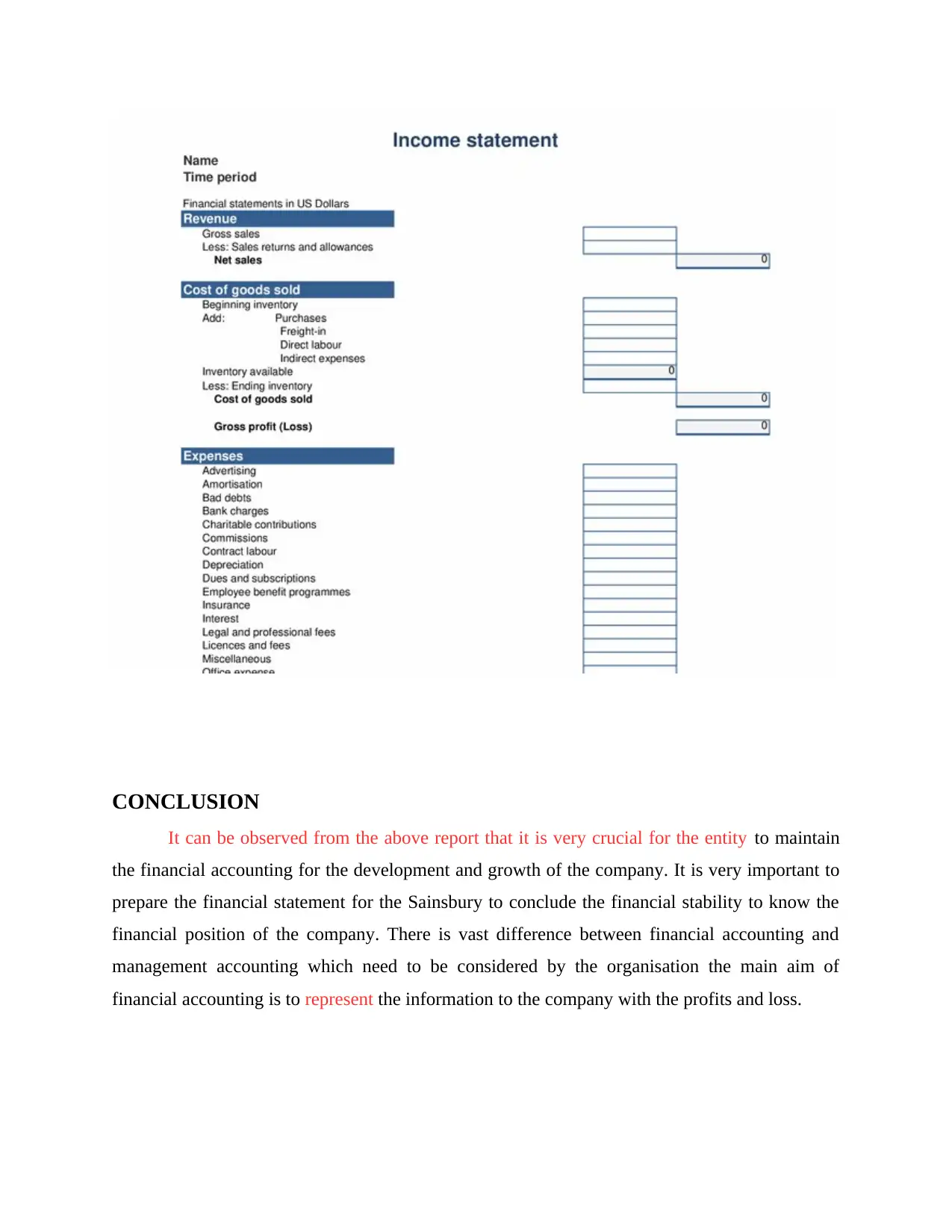
CONCLUSION
It can be observed from the above report that it is very crucial for the entity to maintain
the financial accounting for the development and growth of the company. It is very important to
prepare the financial statement for the Sainsbury to conclude the financial stability to know the
financial position of the company. There is vast difference between financial accounting and
management accounting which need to be considered by the organisation the main aim of
financial accounting is to represent the information to the company with the profits and loss.
It can be observed from the above report that it is very crucial for the entity to maintain
the financial accounting for the development and growth of the company. It is very important to
prepare the financial statement for the Sainsbury to conclude the financial stability to know the
financial position of the company. There is vast difference between financial accounting and
management accounting which need to be considered by the organisation the main aim of
financial accounting is to represent the information to the company with the profits and loss.
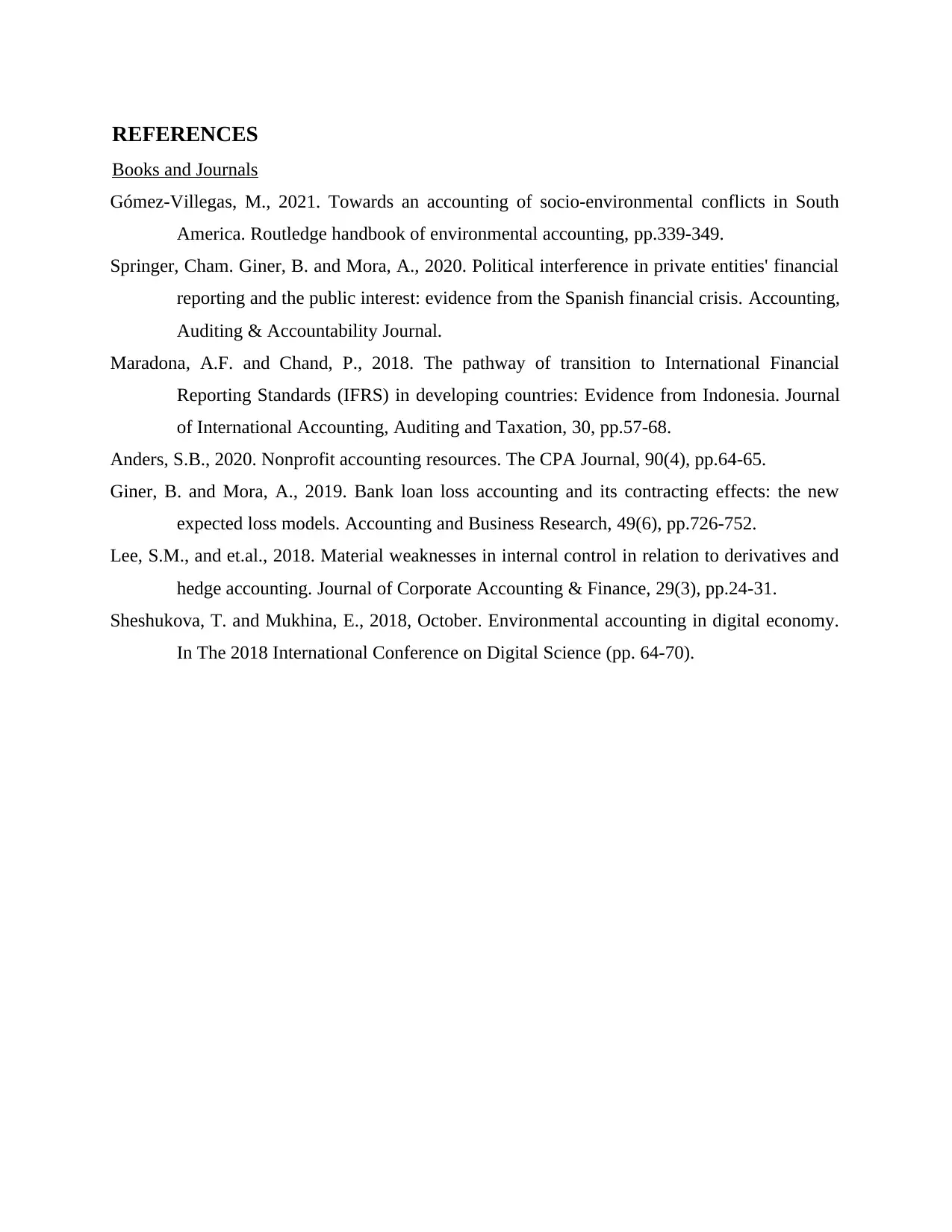
REFERENCES
Books and Journals
Gómez-Villegas, M., 2021. Towards an accounting of socio-environmental conflicts in South
America. Routledge handbook of environmental accounting, pp.339-349.
Springer, Cham. Giner, B. and Mora, A., 2020. Political interference in private entities' financial
reporting and the public interest: evidence from the Spanish financial crisis. Accounting,
Auditing & Accountability Journal.
Maradona, A.F. and Chand, P., 2018. The pathway of transition to International Financial
Reporting Standards (IFRS) in developing countries: Evidence from Indonesia. Journal
of International Accounting, Auditing and Taxation, 30, pp.57-68.
Anders, S.B., 2020. Nonprofit accounting resources. The CPA Journal, 90(4), pp.64-65.
Giner, B. and Mora, A., 2019. Bank loan loss accounting and its contracting effects: the new
expected loss models. Accounting and Business Research, 49(6), pp.726-752.
Lee, S.M., and et.al., 2018. Material weaknesses in internal control in relation to derivatives and
hedge accounting. Journal of Corporate Accounting & Finance, 29(3), pp.24-31.
Sheshukova, T. and Mukhina, E., 2018, October. Environmental accounting in digital economy.
In The 2018 International Conference on Digital Science (pp. 64-70).
Books and Journals
Gómez-Villegas, M., 2021. Towards an accounting of socio-environmental conflicts in South
America. Routledge handbook of environmental accounting, pp.339-349.
Springer, Cham. Giner, B. and Mora, A., 2020. Political interference in private entities' financial
reporting and the public interest: evidence from the Spanish financial crisis. Accounting,
Auditing & Accountability Journal.
Maradona, A.F. and Chand, P., 2018. The pathway of transition to International Financial
Reporting Standards (IFRS) in developing countries: Evidence from Indonesia. Journal
of International Accounting, Auditing and Taxation, 30, pp.57-68.
Anders, S.B., 2020. Nonprofit accounting resources. The CPA Journal, 90(4), pp.64-65.
Giner, B. and Mora, A., 2019. Bank loan loss accounting and its contracting effects: the new
expected loss models. Accounting and Business Research, 49(6), pp.726-752.
Lee, S.M., and et.al., 2018. Material weaknesses in internal control in relation to derivatives and
hedge accounting. Journal of Corporate Accounting & Finance, 29(3), pp.24-31.
Sheshukova, T. and Mukhina, E., 2018, October. Environmental accounting in digital economy.
In The 2018 International Conference on Digital Science (pp. 64-70).
Secure Best Marks with AI Grader
Need help grading? Try our AI Grader for instant feedback on your assignments.

1 out of 11
Related Documents
Your All-in-One AI-Powered Toolkit for Academic Success.
+13062052269
info@desklib.com
Available 24*7 on WhatsApp / Email
![[object Object]](/_next/static/media/star-bottom.7253800d.svg)
Unlock your academic potential
© 2024 | Zucol Services PVT LTD | All rights reserved.




